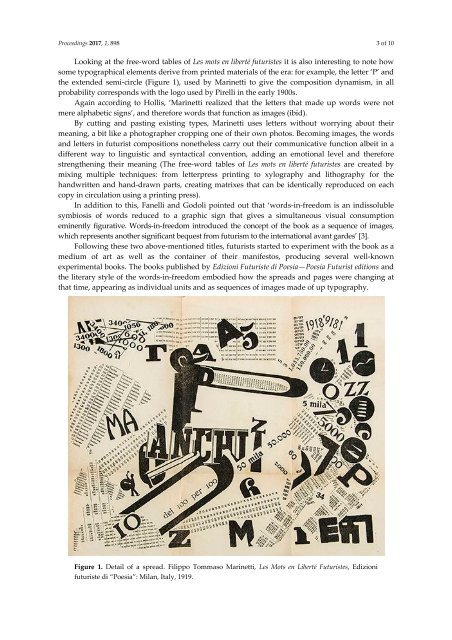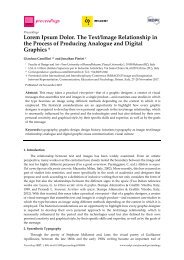proceedings-01-00898
You also want an ePaper? Increase the reach of your titles
YUMPU automatically turns print PDFs into web optimized ePapers that Google loves.
Proceedings 2<strong>01</strong>7, 1, 898 3 of 10<br />
Looking at the free-word tables of Les mots en liberté futuristes it is also interesting to note how<br />
some typographical elements derive from printed materials of the era: for example, the letter ‘P’ and<br />
the extended semi-circle (Figure 1), used by Marinetti to give the composition dynamism, in all<br />
probability corresponds with the logo used by Pirelli in the early 1900s.<br />
Again according to Hollis, ‘Marinetti realized that the letters that made up words were not<br />
mere alphabetic signs’, and therefore words that function as images (ibid).<br />
By cutting and pasting existing types, Marinetti uses letters without worrying about their<br />
meaning, a bit like a photographer cropping one of their own photos. Becoming images, the words<br />
and letters in futurist compositions nonetheless carry out their communicative function albeit in a<br />
different way to linguistic and syntactical convention, adding an emotional level and therefore<br />
strengthening their meaning (The free-word tables of Les mots en liberté futuristes are created by<br />
mixing multiple techniques: from letterpress printing to xylography and lithography for the<br />
handwritten and hand-drawn parts, creating matrixes that can be identically reproduced on each<br />
copy in circulation using a printing press).<br />
In addition to this, Fanelli and Godoli pointed out that ‘words-in-freedom is an indissoluble<br />
symbiosis of words reduced to a graphic sign that gives a simultaneous visual consumption<br />
eminently figurative. Words-in-freedom introduced the concept of the book as a sequence of images,<br />
which represents another significant bequest from futurism to the international avant gardes’ [3].<br />
Following these two above-mentioned titles, futurists started to experiment with the book as a<br />
medium of art as well as the container of their manifestos, producing several well-known<br />
experimental books. The books published by Edizioni Futuriste di Poesia—Poesia Futurist editions and<br />
the literary style of the words-in-freedom embodied how the spreads and pages were changing at<br />
that time, appearing as individual units and as sequences of images made of up typography.<br />
Figure 1. Detail of a spread. Filippo Tommaso Marinetti, Les Mots en Liberté Futuristes, Edizioni<br />
futuriste di “Poesia”: Milan, Italy, 1919.



